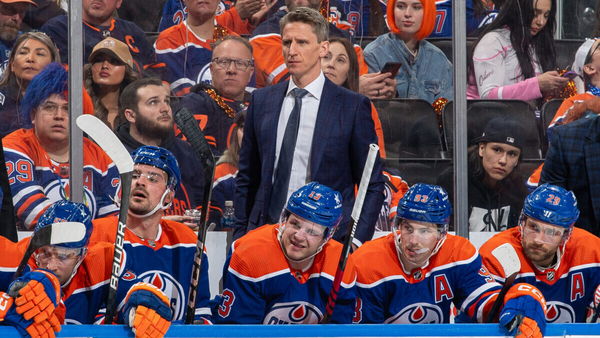
via Getty
EDMONTON, CANADA – APRIL 22: Head coach Kris Knoblauch of the Edmonton Oilers looks on during Game One of the First Round of the 2024 Stanley Cup Playoffs against the Los Angeles Kings at Rogers Place on April 22, 2024, in Edmonton, Alberta, Canada. (Photo by Andy Devlin/NHLI via Getty Images)

via Getty
EDMONTON, CANADA – APRIL 22: Head coach Kris Knoblauch of the Edmonton Oilers looks on during Game One of the First Round of the 2024 Stanley Cup Playoffs against the Los Angeles Kings at Rogers Place on April 22, 2024, in Edmonton, Alberta, Canada. (Photo by Andy Devlin/NHLI via Getty Images)
The future of Canadian NHL teams is in for a significant financial challenge with unprecedented financial growth in the league. With a forecasted sharp rise in salary caps, Canadian teams have a long, arduous ascent in terms of competitiveness under the burden of changing values in currencies and increased expenses. It could become a make-or-break decade for Canadian hockey, but not in the positive manner the Canadian fan base hoped for.
Radical realignment in financial terms in the league could drive its biggest franchises into unexploited seas, with them having to seek alternatives in a desperate attempt to save them in a timely manner. With the NHL forecasting a salary cap rise to $113.5 million USD for 2027-28, following a series of raises to $95.5 million in 2025-26 and $104 million in 2026-27, Canadian teams have an equivalent salary of $163.2 million CAD at current values. With such a high margin, concerns regarding Canadian teams’ competitiveness and financial viability become a cause for alarm.
Where most U.S.-based franchises have a relatively stable financial environment, Canadian ones have to work with unpredictable exchange rates that have a direct impact on player salaries and operational expenses. That financial burden is compounded by the NHL post-pandemic boom, with revenue spiking to $6.2 billion in its most recent campaign. Teams such as Toronto, Montreal, and Edmonton, who consistently spend to the salary cap, will have to explore new sources of revenue in an attempt to keep pace with burgeoning expenses. On the other hand, U.S.-based franchises have a stable financial environment.
ADVERTISEMENT
Article continues below this ad
Real concern for (some) Canadian teams moving forward: a $113.5 million USD salary cap in 2027-28 equates to $163.2 million spending in Canadian dollars based on today's rate.
How will those teams find a way to significantly generate new revenue to match increase?
— Frank Seravalli (@frank_seravalli) January 31, 2025
The NHL model of shared wealth is not a comfort, and Canadian teams will have to go to extreme lengths in a quest to keep pace. That can involve raising ticket prices, taking a larger bite out of sponsorship packages, creating multimedia and international branding, and even rethinking long-term player deals. How much will fall to the fan base, and how much can owner groups manage with success in mind?
ADVERTISEMENT
Article continues below this ad
Sponsorship, revenue streams, and what’s next
The greatest challenge for Canadian franchises is getting larger packages of sponsorship and television in an attempt to mitigate growing financial gaps. Canadian franchises, in contrast to the U.S., have a high overreliance on traditional funding sources, including gate sales and endorsements in the region, whereas, in U.S. counterparts, they have enormous corporation packages and television packages.
The NHL has adopted new sources of revenue such as gambling partnerships with sports, web marketing, and worldwide branding, and it is one in which Canadian teams will have to stretch, and possibly a make-or-break one at that. But will it suffice to keep pace with financial upheaval ruling the league?
ADVERTISEMENT
Article continues below this ad
What’s your perspective on:
Can Canadian franchises keep their stars with the looming financial crunch and rising salary caps?
Have an interesting take?
Unless new sources of significant revenue, such as expansion, arrive, a number of teams will not only suffer in free agency but also in holding onto current stars, competing in standings, and fan attraction. In case the financial squeeze worsens, could a Canadian team even have to move in the future? That is not out of the question—especially with the league and NHLPA gearing up for future CBA negotiations that will have a bearing on revenue distribution and financial planning.
Only time will give a clear picture of the financial future of Canadian hockey. While we wait for that to unfold, what are your thoughts on the same? Let us know in the comments.
ADVERTISEMENT
ADVERTISEMENT
ADVERTISEMENT
ADVERTISEMENT


Can Canadian franchises keep their stars with the looming financial crunch and rising salary caps?